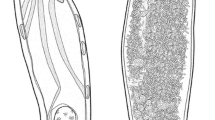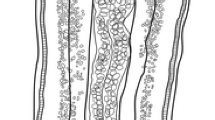Abstract
Specimens described as Rhadinorhynchus niloticus Meyer, 1932 (Rhadinorhynchidae) from two male specimens collected from Heterotis niloticus (Cuvier) in the Egyptian Nile were later redescribed in the genus Tenuisentis Van Cleave, 1936 (Tenuisentidae) based on 12 specimens collected from the same host species in the White Nile. That redescription basically distinguished the two genera based on five traits but did not actually provide a formal description. His account left out information about cerebral ganglion, lemnisci, some reproductive structures, eggs, proboscis hook dissymmetry and roots, size of trunk and a few other structures. We provide (i) the first complete description of this species enhanced by SEM, molecular, and histo-pathological studies; (ii) expand the existing descriptions; (iii) correct questionable accounts advanced by Van Cleave on the cement gland and the hypodermal giant nuclei; and (iv) add descriptions of new features such as the para-receptacle structure which we also report from Paratenuisentis Bullock & Samuel, 1975, the only other genus in Tenuisentidae Van Cleave, 1936. The subsequent description of a few more specimens from the same host collected in Mali was more informative yet incomplete and at variance with our specimens from Burkina Faso. Genetic divergence and phylogenetic analyses of mitochondrial (cytochrome oxidase c subunit I; COI) and nuclear (18S ribosomal RNA) gene relationships uncovered a cryptic species complex containing two lineages. Based on our studies, the family diagnosis is emended. The acanthocephalan causes damage to the host intestine as depicted in histopathological sections. The invading worm can extend from the mucosal layer to the muscularis externa of the host with subsequent tissue necrosis, villi compression, haemorrhaging and blood loss.






Similar content being viewed by others
References
Abowei, J. F. N., & Ezekiel, E. N. (2011). A review of Acanthocephala, leeches, parasite crustaceans, and some other parasites of miscellaneous taxa infections in African fish. International Journal of Animal and Veterinary Advances, 3, 337–351.
Akinsanya, B. (2007). Histopathological study on the parasitized visceral organs of some fishes of Lekki Lagoon, Lagos, Nigeria. Life Science Journal, 4, 70–76.
Akinsanya, B., Hassan, A. A., & Otubanjo, O. A. (2007a). A comparative study of the parasitic helminth fauna of Gymnarchus niloticus (Gymnarchidae) and Heterotis niloticus (Osteoglossidae) from Lekki Lagoon, Lagos Nigeria. Pakistan Journal of Biological Sciences, 10, 427–432.
Akinsanya, B., Hassan, A. A., & Otubanjo, O. A. (2007b). Helminth parasites of Malapterurus electricus (Malapteruridae) from Lekki Lagoon, Lagos, Nigeria. Journal of American Science, 3, 1–6.
Amin, O. M. (2005). Occurrence of the subgenus Acanthosentis Verma & Datta, 1929 (Acanthocephala: Quadrigyridae) in Japan, with the description of Acanthogyrus (Acanthosentis) alternatspinus sp. n. and A. (A.) parareceptaclis sp. n. from Lake Biwa drainage fishes and a key to species of the subgenus. Systematic Parasitology, 60, 125–137.
Amin, O. M., Gholami, Z., Akhlaghi, M., & Heckmann, R. A. (2013). The description and host–parasite relationships of a new quadrigyrid species (acanthocephala) from the Persian tooth-carp, Aphanius farsicus (Actinoptreygii: Cyprinodontidae) in Iran. Journal of Parasitolology, 99, 257–263.
Amin, O. M., Ha, N. V., & Ha, D. N. (2011a). First report of Neoechinorhynchus (Acanthocephala: Neoechinorhynchidae) from marine fish of the eastern seaboard of Vietnam, with the description of six species. Parasite, 18, 21–34.
Amin, O. M., Heckmann, R. A., & Ha, N. V. (2011b). Description of two new species of Rhadinorhynchus (Acanthocephala, Rhadinorhynchidae) from marine fish in Halong Bay, Vietnam, with a key to species. Acta Parasitologica, 56, 67–77.
Amin, O. M., Heckmann, R. A., & Standing, M. D. (2007). The structural-functional relationship of the para-receptacle structure in Acanthocephala. Comparative Parasitology, 74, 383–387.
Amin, O. M., Saoud, M. F. A., & Alkuwari, K. S. R. (2002). Neoechinorhynchus qatarensis sp. n. (Acanthocephala: Neoechinorhynchidae) from the blue-barred flame parrot fish, Scarus ghobban Forsskal, 1775, in Qatari waters of the Arabian Gulf. Parasitolology International, 51, 171–176.
Bray, R. A., & Cribb, T. H. (2015). Are cryptic species a problem for parasitological biological tagging for stock identification of aquatic organisms? Parasitology, 142, 125–133.
Bullock, W. L., & Samuel, G. (1975). Paratenuisentis gen. n. for Tanaorhamphus ambiguus Van Cleave 1921 (Acanthocephala), with a reconsideration of the Tenuisentidae. Journal of Parasitology, 61, 105–109.
Dianou, D., Poda, J. N., Sorgho, H., Wango, S. P., & Sondo, K. B. (2003). Hydraulic plannings and schistosomiasis: Case of Sourou in Burkina Faso. Journal of Applied Research in Veterinary Medicine, 1, 105–111.
Dollfus, R. P., & Golvan, Y. J. (1956). Mission M. Blanc-F. d’Aubenton (1954). V. Acanthocephales de poissons du Niger. Bulletin de l’Institute France Afrique Noire. Sér. A., 18, 1086–1109.
Ekanem, A. P., Eyo, V. O., & Sampson, A. F. (2011). Parasites of landed fish from Great Kwa River, Calabar, Cross River State, Nigeria. International Journal of Fisheries and Aquaculture, 3, 225–230.
Folmer, O., Black, M., Hoeh, W., Lutz, R., & Vrijenhoek, R. (1994). DNA primers for amplification of mitochondrial cytochrome c oxidase subunit I from diverse metazoan invertebrates. Molecular Marine Biology and Biotechnology, 3, 294–299.
Froese, R., & Pauly, D. (Eds) (2015). FishBase. World Wide Web electronic publication. http://www.fishbase.org, Version 4/2015.
García-Varela, M., & Nadler, S. A. (2005). Phylogenetic relationships of Palaeacanthocephala (Acanthocephala) inferred from SSU and LSU rDNA gene sequences. Journal of Parasitology, 91, 1401–1409.
García-Varela, M., Pérez-Ponce de León, G., de la Torre, P., Cummings, M. P., Sarma, S. S. S., & Laclette, J. P. (2000). Phylogenetic relationships of Acanthocephala based on analysis of 18S ribosomal RNA gene sequences. Journal of Molecular Evolution, 50, 432–540.
Giribet, G., Sorensen, M. V., Funch, P., Kristensen, R. M., & Sterrer, W. (2004). Investigations into the phylogenetic position of Micrognathozoa using four molecular loci. Cladistics, 20, 1–13.
Goulding, T. C., & Cohen, C. S. (2014). Phylogeography of a marine acanthocephalan: lack of cryptic diversity in a cosmopolitan parasite of mole crabs. Journal of Biogeography, 41, 965–976.
Gregory, M., Aznar, F. J., Abollo, E., Roura, A., González, A. F., & Pascual, S. (2013). Nyctiphanes couchii as intermediate host for Rhadinorhynchus sp. (Acanthocephala, Echinorhynchidae) from NW Iberian Peninsula waters. Diseases of Aquatic Organisms, 105, 9–20.
Guindon, S., & Gascuel, O. (2003). A simple, fast, and accurate algorithm to estimate large phylogenies by maximum likelihood. Systematic Biology, 52, 696–704.
Herlyn, H. (2001). First description of an epical epidermis cone in Paratenuisentis ambiguus (Acanthocephala: Eoacanthocephala) and its phylogenetic implications. Parasitology Research, 87, 306–310.
Herlyn, H., Martini, N., & Ehlers, U. (2001). Organisation of the praesoma of Paratenuisentis ambiguus (Van Cleave, 1921) (Acanthocephala: Eoacanthocephala), with special reference to the lateral sense organs and musculature. Systematic Parasitology, 50, 105–116.
Herlyn, H., Piskurek, O., Schmitz, J., Ehlers, U., & Zischler, H. (2003). The syndermatan phylogeny and the evolution of acanthocephalan endoparasitism as inferred from 18S rDNA sequences. Molecular Phylogenetics and Evolution, 26, 155–164.
Jobb, G. (2008). TREEFINDER version of October 2008. Munich: Distributed by the author at www.treefinder.de.
Khalil, L. F. (1969). Studies on the helminth parasites of freshwater fishes of the Sudan. Journal of Zoology, London, 158, 143–170.
Kearse, M., Moir, R., Wilson, A., Stones-Havas, S., Cheung, M., Sturrock, S., et al. (2012). Geneious Basic: an integrated and extendable desktop software platform for the organization and analysis of sequence data. Bioinformatics, 28, 1647–1649.
Kiernan, J. A. (2002). Histological and histochemical methods; theory and practice. Edinburgh, UK: Churchill Livingstone, 520 pp.
Lee, R. E. (1992). Scanning Electron Microscopy and X-Ray Microanalysis. Englewood Cliffs, New Jersey, USA: Prentice Hall, 458 pp.
Lillie, R. D. (1991). H. J. Conn’s biological stains, A handbook on the nature and uses of dyes employed in the biological laboratory. St. Louis, Missouri, USA: Sigma Chemical Company, 609 pp.
Malyarchuk, B., Derenko, M., Mikhailova, E., & Denisova, G. (2014). Phylogenetic relationships among Neoechinorhynchus species (Acanthocephala: Neoechinorhynchidae) from North-East Asia based on molecular data. Parasitology International, 63, 100–107.
Manson, K., & Knight, J. (2011). Burkina Faso. Bradt Travel Guides. Guilford, Connecticut, USA: The Globe Pequot Press Inc., 226 pp.
Martínez-Aquino, A., Reyna-Fabián, M., Rosas-Valdez, R., Razo-Mendivil, U., Pérez-Ponce de León, G., & García-Varela, M. (2009). Detecting a complex of cryptic species within Neoechinorhynchus golvani (Acanthocephala: Neoechinorhynchidae) inferred from ITSs and LSU rDNA gene sequences. Journal of Parasitology, 95, 1040–1047.
Mašová, S., Moravec, F., Baruš, V., & Seifertová, M. (2010). Redescription, systematic status, and molecular characterisation of Multicaecum heterosis Petter, Vassiliadès et Marchand, 1979 (Nematoda: Heterocheilidae), an intestinal parasite of Heterotis niloticus (Osteichthyes: Arapaimidae) in Africa. Folia Parasitologica, 57, 280–288.
Meyer, A. (1932). Acanthocephala. Dr. H.G. Bronn’s Klassen und Ordnungen des TierReichs. Akademische Verlagsgesellschaft, Leipzig, 4, 1–332.
Near, T. J., Garey, J. R., & Nadler, S. A. (1998). Phylogenetic relationships of the Acanthocephala inferred from 18S ribosomal DNA sequences. Molecular Phylogenetics and Evolution, 10, 287–298.
Perrot-Minnot, M.-J. (2004). Larval morphology, genetic divergence, and contrasting levels of host manipulation between forms of Pomphorhynchus laevis (Acanthocephala). International Journal for Parasitology, 34, 45–54.
Posada, D. (2008). jModelTest: Phylogenetic Model Averaging. Molecular Biology and Evolution, 25, 1253–1256.
Sagua, V. O. (2006). On a new species of electric catfish from Kainji, Nigeria with some observations on its biology. Journal of Fish Biology, 30, 75–89.
Smrzlić, I. V., Valić, D., Kapetanović, D., Marijić, V. F., Gjurčević, E., & Teskeredžić, E. (2015). Pomphorhynchus laevis (Acanthocephala) from the Sava River basin: New insights into strain formation, mtDNA-like sequences and dynamics of infection. Parasitology International, 64, 243–250.
Swofford, D. L. (2003). PAUP* Phylogenetic Analysis Using Parsimony (*and Other Methods). Version 4. Sunderland, Massachusetts, USA: Sinauer Associates.
Van Cleave, H. J. (1936). Tenuisentis, a new genus of Acanthocephala, and its taxonomic position. Parasitology, 28, 446–451.
Wayland, M. T., Vainio, J. K., Gibson, D. I., Herniou, E. A., Littlewood, D. T. J., & Väinölä, R. (2015). The systematics of Echinorhynchus Zoega in Müller, 1776 (Acanthocephala, Echinorhynchidae) elucidated by nuclear and mitochondrial sequence data from eight European taxa. ZooKeys, 484, 25–52.
Weber, M., Wey-Fabrizius, A. R., Podsiadlowski, L., Witek, A., Schill, R. O., Sugar, L., Herlyn, H., & Hankeln, T. (2013). Phylogenetic analyses of endoparasitic Acanthocephala based on mitochondrial genomes suggest secondary loss of sensory organs. Molecular Phylogenetics and Evolution, 66, 182–189.
Acknowledgements
Thanks to Michael Standing and Kyrie Carpenter, BYU (Brigham Young University) Microscopy, for their professional help with electron optics equipment and plate preparation and editing. We also thank P.R. Pilitt (USNPC) for making it possible to examine the Tenuisentis and Paratenuisentis material.
Funding
This work was supported by an Institutional grant from the Institute of Parasitic Diseases, Scottsdale, Arizona, USA and by funding from the Department of Microbiology and Molecular Biology, Brigham Young University, Provo, Utah, USA.
Author information
Authors and Affiliations
Corresponding author
Ethics declarations
Conflict of interest
The authors declare that they have no conflict of interest.
Ethical approval
All applicable institutional, national and international guidelines for the care and use of animals were followed.
Rights and permissions
About this article
Cite this article
Amin, O.M., Evans, R.P., Boungou, M. et al. Morphological and molecular description of Tenuisentis niloticus (Meyer, 1932) (Acanthocephala: Tenuisentidae) from Heterotis niloticus (Cuvier) (Actinopterygii: Arapaimidae), in Burkina Faso, with emendation of the family diagnosis and notes on new features, cryptic genetic diversity and histopathology. Syst Parasitol 93, 173–191 (2016). https://doi.org/10.1007/s11230-015-9615-7
Received:
Accepted:
Published:
Issue Date:
DOI: https://doi.org/10.1007/s11230-015-9615-7




